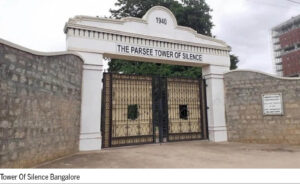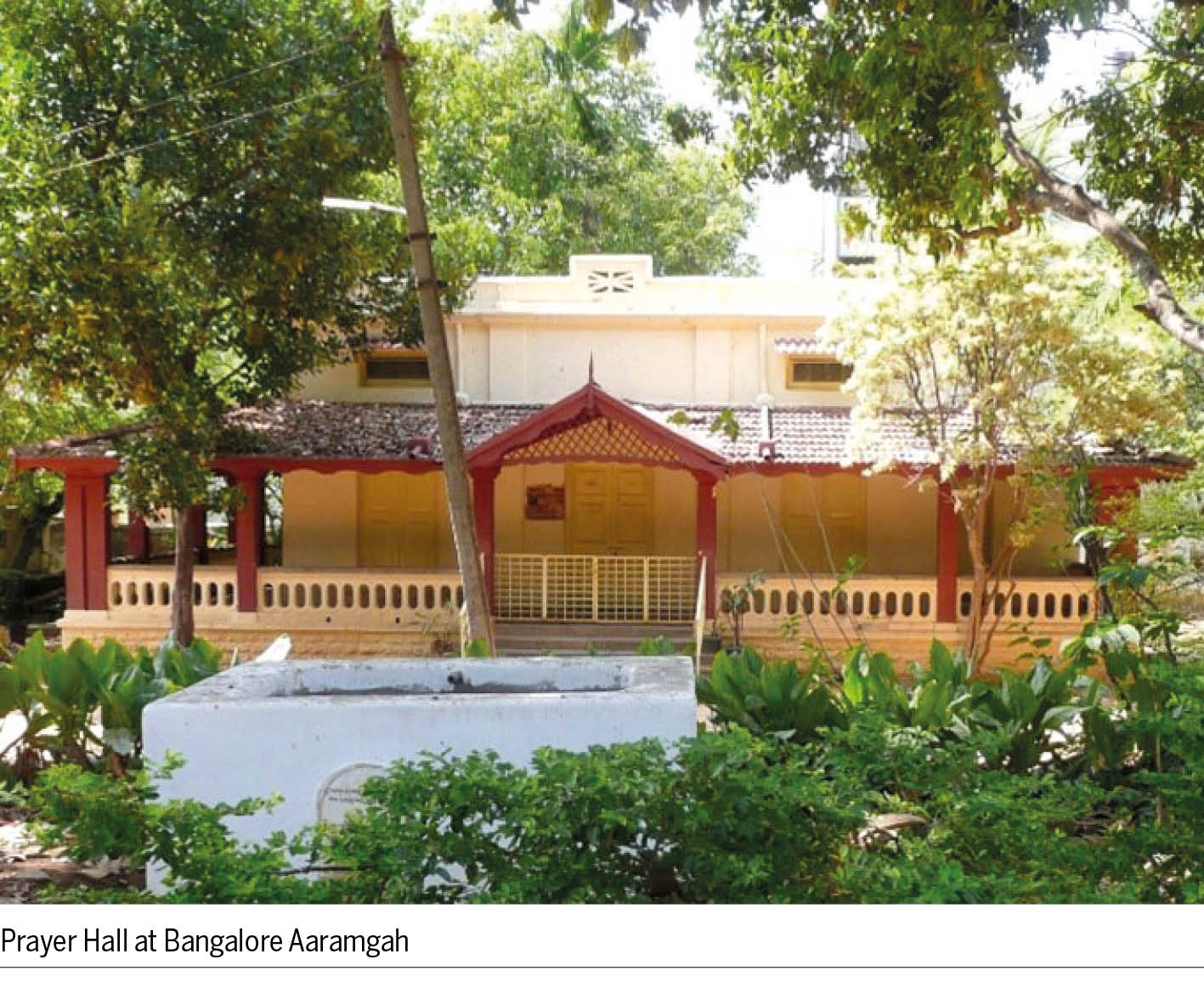Adil J. Govadia
 The exact historical data of Parsi arrival in Mysore or Bangalore remains uncertain as most of the available data is oral and not documented. Only in 1933 was an attempt made by Seth Faramji Cawasji Shroff to chronicle the outlines of Parsi relocation to Bangalore, in his book titled ‘Bangalore-ni Parsi Aaramgah-ni Tuk Tavarikh Tatha Intekhab’. Accordingly, the saga of Parsi migration to Bangalore dates back sometime to the mid-1880s, when Bangalore saw the arrival of the earliest Parsi-Zoroastrian families, namely Seth P. Pallonji (mail contractor), Dr. Hormusji J. Bhabha (first native Inspector-General of Education for Mysore State), Dr. Dosabhai A. Choksi (medical officer with Mysore Medical Services), Seth S.R. Master (Barrister-at-Law), Col. Divecha (a retired military officer), Seth Ratanji A. Captain, Seth B.P. Doctor and Seth Jamshedji A. Engineer.
The exact historical data of Parsi arrival in Mysore or Bangalore remains uncertain as most of the available data is oral and not documented. Only in 1933 was an attempt made by Seth Faramji Cawasji Shroff to chronicle the outlines of Parsi relocation to Bangalore, in his book titled ‘Bangalore-ni Parsi Aaramgah-ni Tuk Tavarikh Tatha Intekhab’. Accordingly, the saga of Parsi migration to Bangalore dates back sometime to the mid-1880s, when Bangalore saw the arrival of the earliest Parsi-Zoroastrian families, namely Seth P. Pallonji (mail contractor), Dr. Hormusji J. Bhabha (first native Inspector-General of Education for Mysore State), Dr. Dosabhai A. Choksi (medical officer with Mysore Medical Services), Seth S.R. Master (Barrister-at-Law), Col. Divecha (a retired military officer), Seth Ratanji A. Captain, Seth B.P. Doctor and Seth Jamshedji A. Engineer.
Sometime in 1890, Seth Muncherji Dosabhai Cama, founder of Bombay’s Cama Convalescent Home, along with his wife Bai Shirinbai, relocated to Bangalore. They were hosted by Dr. Hormusji Bhabha, when Seth Mancherji suddenly fell ill and passed away in 1892. The absence of a Parsi burial ground in Bangalore, had Dr. Bhabha urgently approach the Dewan of Mysore, Sir Seshadri Iyer, to provide a suitable burial place in Bangalore. Seshadri Iyer, personally known to Seth Muncherji Cama, readily agreed to help the Parsi migrants by delegating the Deputy Commissioner of Bangalore to find a suitable burial place for his deceased friend. An appropriate site, measuring 16½ guntas was identified, in what was then described as the Bangalore Taluka, where Seth Muncherji Cama was finally laid to rest on April 1st, 1892, with complete Zoroastrian religious rites.
Subsequently, a wall was constructed surrounding the Government-controlled burial plot, with a small iron gate that still exists today. In May 1896, the community leaders of Bangalore decided to start a donation drive to purchase additional property surrounding the burial plot. With their efforts, in 1900, the ‘Parsi Anjuman’ purchased approximately 2.75 acres on the North, South and East side of the Government-controlled burial plot from the corpus collected through donations.
Thus, continued this loosely-arranged informal treaty of community management for almost 22 years. Then, in 1922, due to the increasing Parsi population in Bangalore, Seth B.P Doctor called for a community meeting to pass a resolution to formalize a suitable Trust Deed. Drafting the ‘first trust deed’ was assigned to Seth Nusserwanji Faramji Mirza, retired Judge from Bhavnagar. On 6th August, 1922, a simple two-paged Trust Deed was formally presented and accepted by the very first ‘Managing Committee’, comprising Seth Belgaumwala, Seth B.P. Doctor and Seth D.K. Darashah.
With this Trust Deed in place, the State Government decided to completely hand over the management of the Parsi burial ground to the first Board of All-Parsi Trustees of the newly constituted ‘Bangalore Parsee Zoroastrian Anjuman’, led by Seth Meherwanji M. Merchant along with Seth Nusserwanji F. Mirza and Seth Ferdoonji F. Dhalla.
In the absence of electricity, Bangalore’s cantonment area was lit by kerosene lamps. Daily routine of lighting the central district of Bangalore Cantonment was a dirty chore: three workers toiled the arduous routine of lighting the street lamps daily, while a ‘Light Inspector’ monitored this routine. The first worker cleaned the black soot in the lamps left from the previous day, the second filled the lamps with kerosene and the third worker lit the flame in every lamp. However, in 1905, urban Bangalore became the first city in peninsular India to get connected to electricity. But since the Bangalore Aaramgah property was situated in a rural area, electrical connection to the Aaramgah property was next to impossible. Thus, it remained lit at night with privately maintained kerosene lanterns that often got extinguished either due to gusty winds or incessant rainfall, thereby posing exasperating hardships to the resident Mali!
This led the prominent community leaders to approach the City Municipality with an urgent request to provide electric connection to the Aaramgah property as a special case. The City Municipality promptly agreed, subject to acceptance of two specific conditions, which the community leaders promptly agreed. Thus, in the year 1920, for the first time, kerosene lanterns were replaced with electric bulbs, bringing electricity to the Aaramgah as also to the surrounding neighborhood, much before the bordering rural area could ever dream of getting connected.
In April 1926, Bai Pirojbai F. Chaina’s munificent donation helped in constructing the Prayer Hall at the Aaramgah, built in the memory of her late husband Seth Fakirji Nanabhai Chaina, and their deceased daughter Bai Aimai Manekshaw Balsara. Thereafter, in 1928, an outer compound wall around the entire Aaramgah property was financed by Seth Gustasp Irani, son of the famous Seth Khodadad Irani, after whom Mumbai’s Khodadad Circle in Dadar is named. Seth Gustasp Irani offered to build the wall in memory of his young son Behman, who studied as a boarder in Bangalore but tragically passed away on 3rd July, 1932, and was laid to rest at the Bangalore Parsi Aaramgah.
In 1910, Dr. Hormusji J. Bhabha retired from government service, a year after the birth of his grandson Homi (who went on to become ‘The Father Of The Indian Nuclear Program’ – Dr Homi Jehangir Bhabha) and returned to Bombay. The initial enthusiasm and passion demonstrated by the likes of Dr. Hormuzji Bhabha and other Parsi settlers towards religious sanctity and Parsi orthodoxy never diminished, as the torch remained ignited and the fire blazed even brighter, each passing day.
